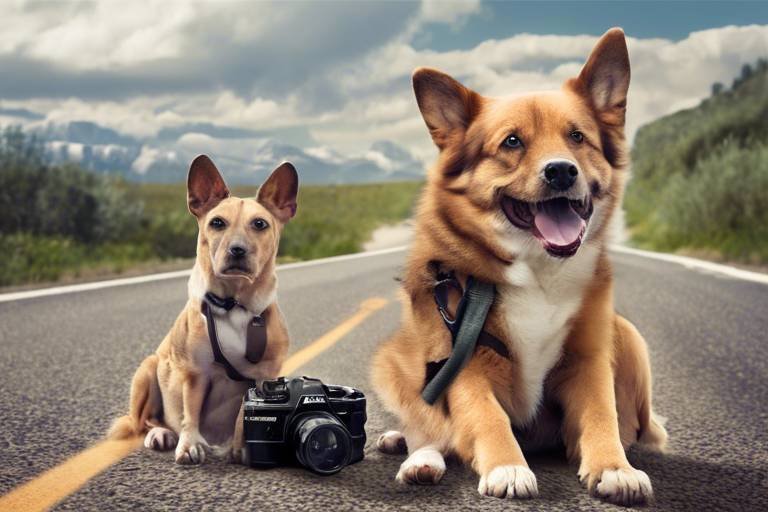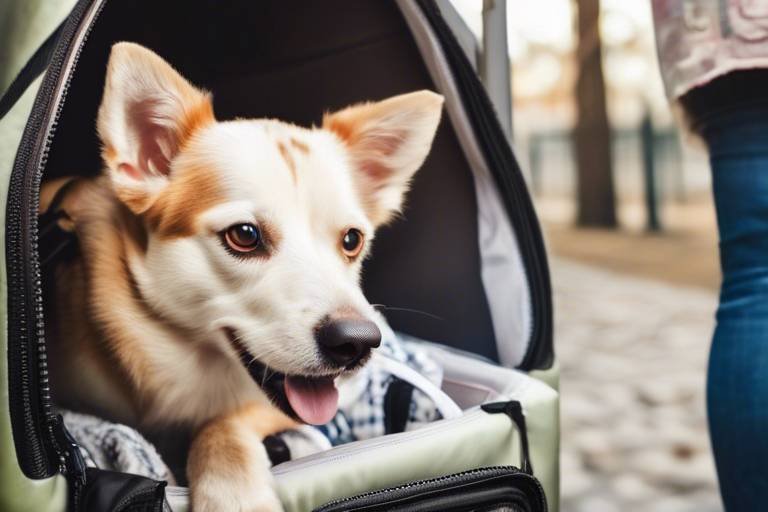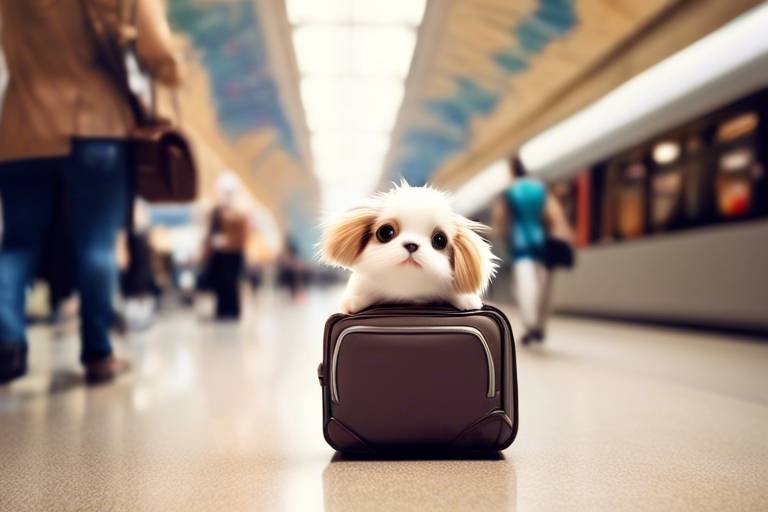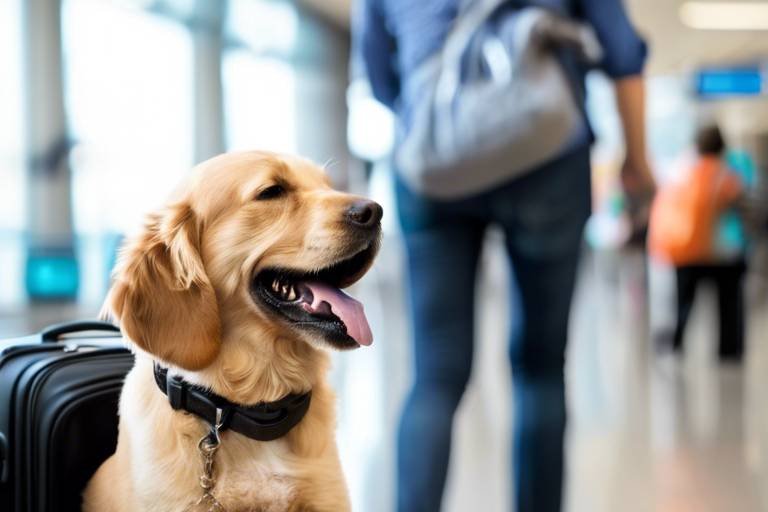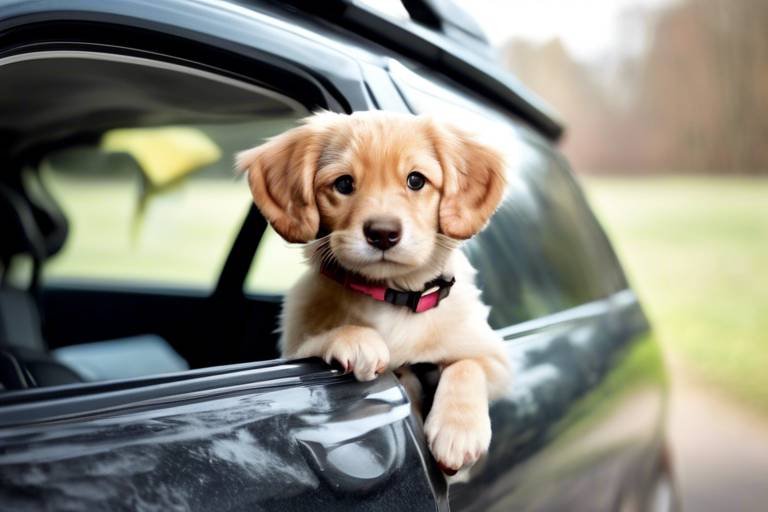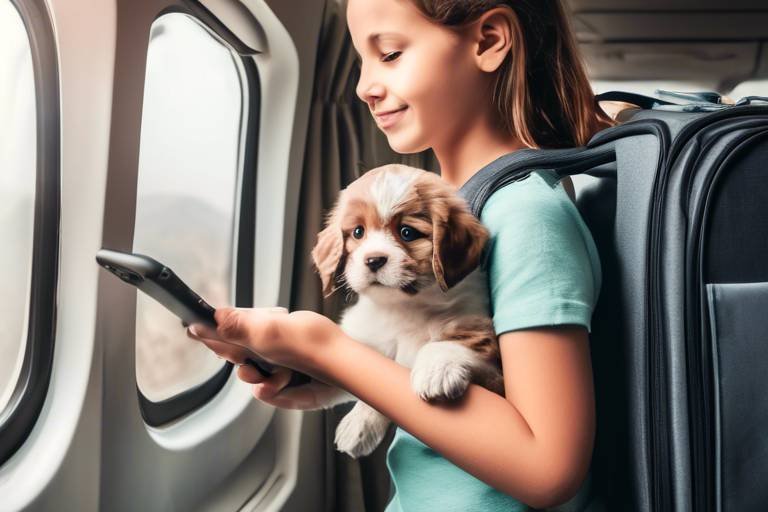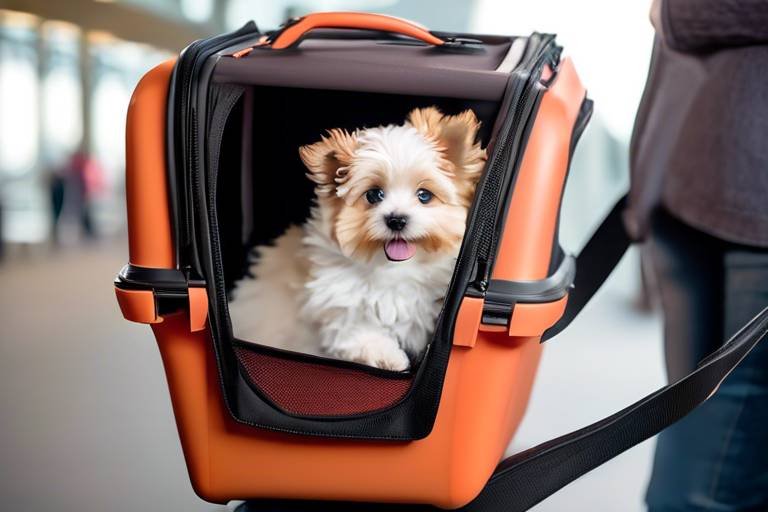Traveling with Dogs - Essential Training Tips
Traveling with our furry companions can be one of the most rewarding experiences, but it also comes with its own set of challenges. As pet owners, we want to ensure that our dogs are not just included in our adventures but are also comfortable and well-behaved throughout the journey. This article provides essential training tips for pet owners who wish to travel with their dogs, ensuring a smooth and enjoyable experience for both the pet and the owner. Whether you’re planning a road trip, a flight, or a simple day out, understanding your dog’s needs and behaviors is key to a successful travel experience.
Recognizing your dog's behavior is crucial for successful travel. Dogs, much like humans, have their own personalities and quirks, which can significantly affect how they respond to new environments. For instance, some dogs may be naturally curious and eager to explore, while others might feel anxious or fearful in unfamiliar settings. It's important to observe your dog's body language and reactions in different situations. Are they wagging their tail, indicating excitement, or are they cowering, showing signs of stress? By understanding these behaviors, you can better prepare for various situations that may arise during your travels. This knowledge not only helps in managing your dog's reactions but also in creating a more enjoyable atmosphere for everyone involved.
Teaching your dog basic commands like sit, stay, and come can significantly enhance travel experiences. These commands serve as a foundation for good behavior and can help you maintain control in busy or stressful situations. For example, when you arrive at a crowded rest area, being able to command your dog to sit or stay can prevent them from darting off and getting into trouble. Consistent training in these commands before your trip can make a world of difference. Not only does it strengthen the bond between you and your dog, but it also instills a sense of security for both of you. Practice these commands regularly, and reward your dog with treats to reinforce positive behavior.
Leash training is vital for safety during travel. A well-trained dog on a leash can make navigating new environments much easier. Start by introducing your dog to the leash in a familiar setting. Allow them to get used to the feel of the leash and collar before heading out. Use positive reinforcement, such as treats or praise, whenever your dog walks calmly beside you. This not only encourages good behavior but also makes walks more enjoyable. If your dog tends to pull or become distracted, consider using a no-pull harness, which can provide better control without causing discomfort.
Selecting the appropriate leash can make a difference in your dog's behavior while traveling. There are various types of leashes available, including standard leashes, retractable leashes, and even hands-free options. Each type serves different purposes:
| Type of Leash | Best For |
|---|---|
| Standard Leash | General walking and training |
| Retractable Leash | Allowing your dog to explore while still being controlled |
| Hands-Free Leash | Jogging or hiking with your dog |
Choosing the right leash depends on your dog's size, behavior, and the type of activities you plan to do together.
Teaching your dog proper leash etiquette helps prevent pulling and distractions. Start by practicing in a quiet area before moving to busier locations. If your dog begins to pull, stop walking until they return to your side. This technique reinforces that pulling will not get them where they want to go. Additionally, rewarding your dog for walking calmly can create a positive association with staying close to you. Remember, patience and consistency are key!
Desensitizing your dog to various travel environments can reduce anxiety. Gradual exposure to new sights, sounds, and experiences can help your dog feel more comfortable. Start with short trips to nearby parks or pet-friendly stores. Over time, increase the duration and distance of your outings. This method allows your dog to build confidence and adapt to new situations without feeling overwhelmed. Always monitor their reactions and provide comfort as needed, ensuring they feel secure during these new experiences.
Planning a road trip with your dog requires preparation. Start by mapping out pet-friendly stops along your route. This ensures you can take breaks for bathroom needs and exercise. Additionally, consider your dog's comfort during the drive. A well-ventilated crate or a pet seatbelt can keep them safe while allowing them to enjoy the view. Remember to pack plenty of water and snacks to keep them hydrated and energized.
Creating a packing checklist can help you remember all necessary items for your dog. Here are some must-have supplies for a smooth travel experience:
- Food and water bowls
- Dog food and treats
- Leash and collar
- Waste bags
- First-aid kit
- Favorite toys or blankets
Having these items on hand can make your travels much more enjoyable and stress-free.
Keeping your dog healthy and safe during travel is paramount. Before hitting the road, ensure your dog is up to date on vaccinations and flea/tick prevention. Consider scheduling a vet check-up if you're planning a long trip. Also, familiarize yourself with pet-friendly accommodations and emergency veterinary clinics along your route. This preparation can provide peace of mind, allowing you to focus on enjoying your travels together.
Flying with dogs presents unique challenges. It’s essential to check airline policies regarding pet travel, as these can vary significantly. Some airlines allow pets in the cabin, while others require them to be transported in cargo. Additionally, consider your dog’s temperament and size when deciding on air travel. If your dog is small enough to fit in a carrier under the seat, this can be a more comfortable option for them.
Selecting an appropriate carrier is crucial for air travel. The carrier should be well-ventilated, secure, and large enough for your dog to stand, turn around, and lie down comfortably. Look for carriers that meet airline specifications and consider adding familiar items, such as a blanket or toy, to help your dog feel more at ease during the flight.
Understanding airport security procedures can ease the travel experience. Before arriving at the airport, practice getting your dog in and out of their carrier. This can help reduce stress during security checks. Be prepared to remove your dog from the carrier while it goes through the scanner, and keep them on a leash to prevent them from wandering. Staying calm and patient will help your dog feel more secure during the process.
Q: Can I take my dog on a plane?
A: Yes, many airlines allow pets to travel in the cabin or cargo. Always check specific airline policies before booking your flight.
Q: How can I calm my dog during travel?
A: Gradual desensitization to travel environments, using familiar items, and practicing basic commands can help calm your dog during travel.
Q: What should I pack for my dog on a road trip?
A: Essential items include food, water, bowls, leash, waste bags, first-aid kit, and your dog's favorite toys or blankets.

Understanding Your Dog's Behavior
Traveling with your dog can be one of the most rewarding experiences, but it requires a keen understanding of your furry friend's behavior. Just like humans, dogs have their own unique personalities and quirks, which can significantly impact how they react in different situations. For instance, some dogs are naturally adventurous and thrive on new experiences, while others may feel anxious or overwhelmed when faced with unfamiliar environments. It's essential to recognize these behaviors to prepare effectively for your journey.
One common behavior to watch for is anxiety. Many dogs may experience anxiety during travel, especially if they are not used to being in a car or airplane. Signs of anxiety can include excessive barking, panting, or even attempts to escape. Understanding these signals will help you create a more comfortable travel environment for your pet. Take note of how your dog reacts to different situations, and consider gradually exposing them to travel-related experiences before your trip. For example, short car rides can help acclimate your dog to longer journeys.
Another important aspect to consider is your dog's socialization skills. Dogs that are well-socialized tend to handle new environments and encounters with other animals or people more easily. If your dog is shy or aggressive towards strangers, it’s crucial to work on their social skills before embarking on your travels. You can do this by introducing them to new people and pets in controlled settings. This gradual exposure will help build their confidence and reduce potential issues during your trip.
Additionally, pay attention to your dog's body language. Dogs communicate a lot through their posture and movements. For example, a wagging tail usually indicates happiness, while a tucked tail may signal fear or discomfort. Being aware of these cues can help you respond appropriately to your dog’s needs during travel. If you notice your dog becoming restless or agitated, it may be time for a break or some reassurance.
To summarize, understanding your dog's behavior is vital for a successful travel experience. By recognizing signs of anxiety, focusing on socialization, and paying attention to body language, you can create a more enjoyable journey for both you and your furry companion. Remember, the key to a smooth travel experience lies in preparation and awareness of your dog's unique needs.

Basic Commands for Travel
When it comes to traveling with your furry companion, having a few basic commands up your sleeve can make all the difference. Imagine embarking on a road trip or heading to the airport, and your dog is calm and well-behaved. Sounds dreamy, right? Well, it can be your reality with some consistent training! The key commands that every traveling dog should master include sit, stay, come, and leave it. These commands not only enhance your dog's safety but also ensure a smoother travel experience for both of you.
The command sit is foundational. It teaches your dog to settle down, making it easier to manage them in busy environments like airports or rest stops. When your dog is sitting, they're less likely to dart off or become overly excited. To train this command, use treats and positive reinforcement. Start in a quiet space, and once your dog has mastered it, gradually introduce distractions.
Next up is the stay command. This one can be a game-changer when you need your dog to remain in one spot while you handle luggage or check in for your flight. Begin by asking your dog to sit, then take a step back. If they stay in place, reward them! Increase the distance over time, and soon they'll be able to stay put even when you're a few feet away. This command builds trust and helps your dog understand that it's okay to wait patiently.
The come command is essential for safety, especially in unfamiliar places. Picture this: your dog spots a squirrel and bolts towards it. If they don’t come back when called, it could lead to dangerous situations. Training your dog to come when called can be done by using a long leash in a safe area. Start by calling them excitedly, and reward them with treats and praise when they reach you. With enough practice, your dog will associate coming to you with positive experiences!
Lastly, the leave it command is crucial for preventing your dog from picking up something harmful or distracting during your travels. This command can save your dog from ingesting something dangerous or getting into trouble. To teach this command, hold a treat in your hand and let your dog sniff it. When they try to grab it, close your hand and say "leave it." Once they back off, reward them with a different treat. This method teaches them self-control, which is invaluable on the road.
Now, you might be wondering, how do I incorporate these commands into our travel routine? The answer lies in consistency and practice. Try to work on these commands daily, even if it's just for a few minutes. You can practice in various environments to help your dog adapt to different stimuli. For instance, practice sit and stay at home, then at a park, and eventually in a busy area. The more they practice, the more confident and obedient they will become.
In summary, mastering these basic commands not only enhances your dog's behavior during travel but also strengthens the bond between you two. Training should be a fun and rewarding experience for both of you. So, grab some treats, find a quiet space, and start practicing! Your future adventures together will be much more enjoyable, and who knows, you might even turn some heads with how well-behaved your pup is!
- How long does it take to train my dog on these commands? - Training time varies by dog, but with consistent practice, you can see improvement in a few weeks.
- Can I train my dog while traveling? - Absolutely! Use travel time to reinforce commands in new environments.
- What if my dog doesn’t respond to commands in public? - Stay patient and practice regularly. Gradually introduce distractions during training.
Leash Training Techniques
When it comes to traveling with your dog, mastering leash training techniques is essential for a smooth and enjoyable experience. Imagine this: you're excited to hit the road, but as soon as you step outside, your dog starts pulling and tugging, turning your peaceful stroll into a chaotic chase. To avoid this scenario, you need to equip yourself with effective leash training strategies that promote calmness and obedience.
One of the most effective techniques is the “Stop and Go” method. This approach involves stopping whenever your dog pulls on the leash. By halting your progress, you send a clear message that pulling won’t get them anywhere. Once your dog returns to your side, reward them with praise or a treat. This not only reinforces good behavior but also teaches them that walking calmly beside you is the way to go.
Another valuable technique is the “Heel” command. Teaching your dog to walk at your side on command can significantly enhance your travel experience. Start in a quiet area, and with a treat in hand, encourage your dog to walk next to you. When they do, say “heel” and reward them. Gradually increase the distractions as your dog becomes more proficient, and soon enough, they’ll associate the command with the action.
Consistency is key in leash training. Make sure every family member uses the same commands and techniques. This consistency helps your dog understand what is expected of them, reducing confusion and frustration. You might also consider using different types of collars or harnesses that can aid in training. For instance, a front-clip harness can help reduce pulling by redirecting your dog's motion towards you.
To further enhance your leash training, it's beneficial to incorporate short training sessions into your daily routine. Aim for 5 to 10 minutes of focused training a few times a day. This keeps your dog engaged and helps them retain what they’ve learned. Remember, practice makes perfect, and the more you train, the better your dog will behave on the leash.
Lastly, be patient! Every dog learns at their own pace. Celebrate the small victories along the way, whether it's a successful walk around the block or a calm sit at a busy park. With time, patience, and the right techniques, you’ll transform your dog into a well-mannered travel companion.
- How long does leash training take? Leash training can vary significantly depending on your dog’s age, breed, and temperament. Some dogs may catch on quickly, while others might take weeks or even months. Consistency and practice are key!
- What type of leash is best for training? A standard 6-foot leash is often recommended for training. Avoid retractable leashes as they can encourage pulling and make it harder to control your dog.
- Can I train my dog to walk off-leash? While off-leash training is possible, it requires a solid foundation of on-leash training first. Ensure your dog responds reliably to commands before attempting off-leash walks.
Choosing the Right Leash
When it comes to traveling with your dog, selecting the right leash is not just a matter of personal preference; it's a crucial decision that can significantly impact your journey. Imagine this: you're at a bustling rest stop or a crowded airport, and your dog suddenly sees a squirrel or another dog. The last thing you want is a flimsy leash that can't hold up against your pup's excitement! Therefore, understanding the different types of leashes available is essential for ensuring both your dog's safety and your peace of mind.
There are several types of leashes, each designed for specific needs and situations. For instance, a standard leash—typically 4 to 6 feet long—offers excellent control and is perfect for everyday use. It's great for walks around the neighborhood or when you're exploring new places with your dog. On the other hand, a retractable leash allows your dog more freedom to roam while still being attached to you. However, they can sometimes lead to tangles and are not always the best choice in crowded environments.
Another option is the training leash, which is usually longer, allowing for more distance between you and your dog while still maintaining control. This can be particularly beneficial when you’re working on commands like "stay" or "come." Additionally, if your dog is a puller, consider investing in a no-pull leash or harness that discourages pulling by redirecting your dog's attention. These leashes can make a world of difference, especially during travel when distractions are everywhere!
When choosing the right leash, consider the following factors:
- Durability: Ensure the leash is made of high-quality materials that can withstand wear and tear.
- Comfort: Look for padded handles for your comfort, especially during long walks or hikes.
- Length: A longer leash gives your dog more freedom, but a shorter one offers more control in busy areas.
In addition to the leash itself, consider the clip that attaches to your dog's collar or harness. A sturdy, secure clip is essential, as it ensures your dog won't accidentally break free. Some leashes come with reflective materials, which can be a lifesaver during nighttime walks or in low-light conditions.
Ultimately, the right leash can enhance your travel experience, making it more enjoyable for both you and your furry companion. So, before you hit the road or take to the skies, take a moment to evaluate your leash options. Your dog will thank you for it!
1. What type of leash is best for traveling?
A standard leash is generally best for traveling, as it provides control and safety in various environments. However, if your dog is an experienced traveler, a retractable leash can offer more freedom in open areas.
2. How do I know if a leash is durable?
Look for leashes made from high-quality materials, such as nylon or leather, and check for reinforced stitching and sturdy clips. Reading reviews can also help gauge durability.
3. Can I use a harness with a leash?
Absolutely! Using a harness can provide better control and comfort for your dog, especially if they tend to pull. Just make sure the harness fits properly to avoid any discomfort.
4. Should I choose a leash with reflective features?
Yes, reflective leashes are a great choice for nighttime walks or in low-light conditions, as they enhance visibility and safety.
Practicing Leash Etiquette
When it comes to traveling with your dog, practicing leash etiquette is not just a good idea; it's essential for a smooth and enjoyable experience. Imagine this: you're strolling through a bustling airport or a crowded park, and your dog is pulling you in every direction, barking at every passerby. Not only is this stressful for you, but it can also be overwhelming for your furry friend. So, how can you ensure your dog behaves well on a leash? Let's dive into some effective strategies that will help you and your dog navigate the world with grace and confidence.
First and foremost, consistency is key. When you start training your dog to walk on a leash, make sure to use the same commands and techniques every time. If you tell your dog to "heel" one day and "come" the next, it's going to be confusing for them. Instead, establish a clear set of commands that you will stick to, and be patient as your dog learns what you expect from them.
Another crucial aspect of leash etiquette is teaching your dog to walk beside you rather than in front. This not only keeps your dog safe but also allows you to maintain control in busy environments. To encourage this behavior, reward your dog with treats and praise when they walk calmly next to you. You can even use a technique called the "stop-and-go" method: when your dog pulls ahead, stop walking. Wait until they return to your side before continuing. This teaches them that pulling doesn’t get them anywhere.
Additionally, it's vital to expose your dog to various distractions while on a leash. Start in a quiet area, then gradually introduce them to more stimulating environments. This could include busy streets, parks, or even crowded events. By doing this, your dog will learn to focus on you despite the distractions around them. Remember to remain calm and assertive; dogs can pick up on your energy, and if you're anxious, they might become anxious too.
To help reinforce good behavior, consider incorporating some practice sessions into your daily routine. For instance, take a few minutes each day to practice leash walking in your yard or around the block. You can even set up small obstacles or distractions to simulate real-world scenarios. This not only keeps your dog mentally stimulated but also strengthens the bond between you and your pet.
Lastly, don’t forget the importance of proper equipment. A comfortable, well-fitted harness can make a world of difference in leash training. Unlike traditional collars, which can put pressure on your dog’s neck, a harness distributes pressure across their body, providing better control and comfort. Pair this with a sturdy leash, and you'll be well on your way to mastering leash etiquette.
In summary, practicing leash etiquette is about establishing clear communication and building trust between you and your dog. With patience, consistency, and a little bit of practice, you can transform your walks into a delightful experience for both of you. So, grab that leash, and let’s hit the road with confidence!
- What is the best type of leash for training? A standard, 6-foot leash is typically best for training, as it gives you enough control without being too restrictive.
- How long should I practice leash training each day? Short, consistent sessions of about 10-15 minutes are effective. It's better to practice frequently than to overwhelm your dog with long sessions.
- What should I do if my dog continues to pull on the leash? If your dog pulls, stop walking. Wait for them to return to your side before moving again. Consistency is key!
- Can I use treats during leash training? Absolutely! Treats are a great way to reward good behavior and reinforce training.
Desensitization to Travel Environments
Traveling with your dog can be one of the most rewarding experiences, but it often comes with its own set of challenges. One of the biggest hurdles is ensuring that your furry friend is comfortable and calm in new environments. Just like humans, dogs can feel anxious when faced with unfamiliar sights, sounds, and smells. Desensitization is a technique that can help your dog adjust to these travel environments, making the journey smoother for both of you.
Start by exposing your dog to different environments gradually. This could mean taking them to a busy park, a bustling street, or even a pet-friendly café. The key is to introduce these new settings slowly and in a controlled manner. For instance, if you plan to travel by plane, you might want to simulate the airport experience by visiting a local terminal. Let your dog sniff around, listen to the sounds, and get used to the hustle and bustle without the pressure of a real travel situation.
During these practice sessions, it’s crucial to maintain a calm demeanor. Dogs are incredibly perceptive and can pick up on your emotions. If you remain relaxed and positive, your dog is more likely to mirror that behavior. Carry some of their favorite toys or treats to create a positive association with these new experiences. Whenever your dog shows signs of calmness, reward them with praise or a treat. This reinforces the idea that new environments can be enjoyable.
Another effective method is to use desensitization techniques that involve gradual exposure to various stimuli. For instance, if your dog is afraid of loud noises, you might play recordings of sounds they’ll encounter during travel—like airport announcements or the sound of an airplane taking off—at a low volume. Gradually increase the volume over time while ensuring your dog remains calm. This process can help them become accustomed to these sounds without feeling overwhelmed.
Additionally, consider the following steps to help your dog adapt:
- Short Trips: Start with short car rides or visits to new places. Gradually increase the duration and complexity of these outings.
- Positive Reinforcement: Always reward your dog for good behavior in new environments. This could be through treats, praise, or extra playtime.
- Routine Building: Create a routine that includes travel-related activities, such as getting in and out of the car or practicing waiting in line.
By employing these techniques, you can help your dog become more adaptable and less anxious when it comes to travel. Remember, the goal is to create a positive experience that builds their confidence. With time, patience, and practice, your dog will learn to embrace new environments, making your travels together an adventure to cherish.
Q: How long does it take for a dog to become desensitized to travel environments?
A: The time it takes can vary greatly depending on the individual dog's temperament and previous experiences. Some dogs may adjust quickly, while others may need weeks or even months of gradual exposure.
Q: What if my dog shows signs of severe anxiety during desensitization?
A: If your dog exhibits severe anxiety, it may be beneficial to consult with a professional dog trainer or a veterinarian who can provide guidance tailored to your dog's specific needs.
Q: Can I use medication to help my dog with travel anxiety?
A: In some cases, veterinarians may prescribe medication to help manage anxiety during travel. However, this should be considered a last resort, and it’s best to explore behavioral training methods first.
Q: Is it necessary to desensitize my dog if they seem comfortable with travel?
A: While some dogs may appear comfortable, desensitization can still be beneficial by preparing them for unexpected situations that may arise during travel.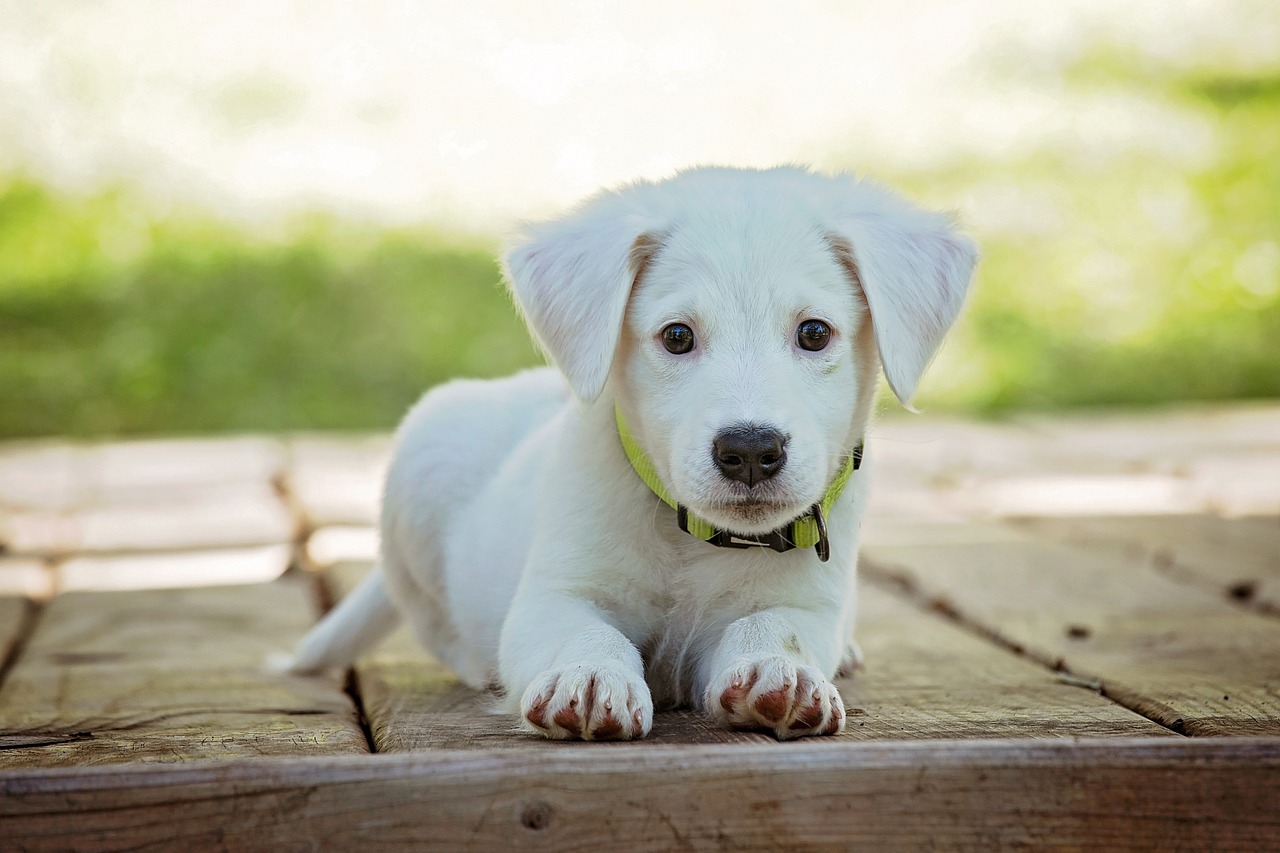
Preparing for Road Trips
Planning a road trip with your furry companion can be an exhilarating experience, but it does require a bit of preparation to ensure that both you and your dog have a fantastic time. Imagine setting off on an adventure, the wind in your hair, your favorite tunes playing, and your loyal pup happily wagging their tail beside you. To make this vision a reality, there are several essential steps you need to take.
First and foremost, it’s crucial to consider your dog's comfort during the journey. Just like us, dogs can get restless during long car rides. To keep your dog relaxed and happy, make sure to take regular breaks. Plan your route to include stops every couple of hours. This not only gives your dog a chance to stretch their legs and relieve themselves but also allows for some quality bonding time. Think of these breaks as mini-adventures along the way!
Next, let’s talk about packing. You might be wondering, “What do I need to take for my dog?” Well, creating a packing checklist can help you remember all the necessary items. Here’s a quick overview of what to include:
- Food and Water: Bring enough food for the entire trip, plus some extra just in case. Don’t forget a portable water bowl!
- Leash and Harness: A sturdy leash and a comfortable harness are essential for safety during rest stops.
- Comfort Items: Bring along your dog’s favorite blanket or toy to help them feel at home.
- First Aid Kit: A basic first aid kit for pets can be a lifesaver in case of minor injuries.
Moreover, ensuring your dog is healthy and safe during travel is paramount. Before you hit the road, schedule a vet check-up to confirm your dog is fit for travel. Discuss any concerns you may have, and make sure your dog is up-to-date on vaccinations. If your dog gets anxious during travel, your vet might recommend some calming solutions to help ease their nerves.
Lastly, consider your dog's travel arrangements. If your dog is not used to being in a car, it might be a good idea to start with short trips leading up to your big adventure. This gradual exposure can help reduce anxiety and make the actual road trip feel less daunting. Think of it as training for a marathon; you wouldn’t just jump into a 26.2-mile run without some preparation, right?
So, as you gear up for your road trip, remember that a little planning goes a long way. With the right preparations, you and your dog can create unforgettable memories together on the open road!
Q: How can I keep my dog calm during long car rides?
A: Regular breaks, familiar items like toys or blankets, and even calming treats can help keep your dog relaxed during long journeys.
Q: Should I feed my dog before or during the trip?
A: It's best to feed your dog a few hours before the trip to avoid motion sickness. Bring snacks for breaks instead.
Q: How can I ensure my dog is safe in the car?
A: Use a pet seatbelt, harness, or a travel crate to keep your dog secure while driving. Never let them ride with their head out of the window.
Q: What if my dog gets carsick?
A: If your dog has a history of motion sickness, consult your vet for advice and possible medications to help manage it.
Essential Packing Checklist
When you're gearing up for a road trip with your furry companion, having an can make all the difference in ensuring a smooth and enjoyable journey. Imagine setting off on an adventure, only to realize halfway there that you've forgotten your dog's favorite blanket or their food! To avoid such hiccups, it's vital to prepare a comprehensive list of items that your dog will need. Here’s a breakdown of the essentials to consider:
First and foremost, food and water supplies are crucial. Make sure to pack enough food for the duration of your trip, plus a little extra in case of delays. It's also a good idea to bring along a portable water bowl and a supply of fresh water, especially if you’re traveling to areas where clean water may not be readily available. Remember, hydration is key!
Next, don't forget the health and safety items. This includes your dog’s medications, a first-aid kit tailored for pets, and any vaccination records that might be required. Additionally, a copy of your vet's contact information can be a lifesaver in case of emergencies. You might also want to bring along a familiar toy or blanket to help your dog feel more at home during the journey.
Another important aspect to consider is your dog's comfort. Items such as a comfortable bed or a blanket can help provide a cozy spot for your dog to relax during long stretches of travel. If your dog is prone to anxiety, consider packing a calming aid, such as a calming collar or a favorite chew toy. Additionally, be sure to include a leash and harness, as well as a backup leash, in case one gets lost or damaged.
For those who plan to stop at various locations, having a travel crate or carrier is essential. This not only keeps your dog safe during travel but also provides a secure space for them when you're at your destination. Be sure to check that the crate is well-ventilated and large enough for your dog to stand, turn around, and lie down comfortably.
Lastly, it’s wise to have a travel document folder that contains all necessary paperwork, including your dog's identification tags, microchip information, and any travel permits if required. This ensures that you’re prepared for any situation that might arise, whether it’s a routine stop or an unexpected detour.
To sum it all up, here’s a quick reference table of your essential packing checklist:
| Item | Purpose |
|---|---|
| Dog Food | Nutrition for your dog during the trip |
| Water Bowl | To keep your dog hydrated |
| First-Aid Kit | For any emergencies |
| Comfort Items | To help reduce anxiety |
| Travel Crate | Safety during travel and at destinations |
| Travel Document Folder | Keep all important papers organized |
By following this essential packing checklist, you’ll be well on your way to ensuring that both you and your dog have a fantastic journey filled with joy and adventure. Remember, preparation is key, and with the right supplies, your road trip can be a memorable experience for both you and your four-legged friend.
Q: What should I do if my dog gets anxious during travel?
A: Consider bringing calming aids such as a favorite toy, blanket, or even a calming collar. Gradually desensitize your dog to travel environments before the trip.
Q: How often should I stop for my dog during a road trip?
A: It's recommended to stop every 2-3 hours to allow your dog to stretch, relieve themselves, and hydrate.
Q: Can I travel with my dog on a plane?
A: Yes, but you need to check the airline's specific requirements regarding carriers, health certificates, and any other regulations.
Health and Safety Considerations
When embarking on a journey with your furry friend, prioritizing their health and safety is essential. Traveling can be exciting, but it can also pose certain risks to your dog. To ensure a smooth experience, it's crucial to conduct a thorough health check before you hit the road. Schedule a visit to your veterinarian to confirm that your dog is fit for travel. This is especially important if you're planning a long trip or if your dog has any pre-existing health conditions. Remember, a healthy dog is a happy travel companion!
Before you leave, make sure your dog is up-to-date on vaccinations. Many places, such as dog parks or pet-friendly hotels, require proof of vaccination. Additionally, consider getting a health certificate from your vet, especially if you're flying or crossing state lines. This certificate serves as documentation that your dog is healthy and free of contagious diseases.
Another crucial aspect of traveling with your dog is ensuring their safety during transit. Whether you're driving or flying, there are specific precautions you should take. For road trips, never let your dog stick their head out of the window; it may look fun, but it can be dangerous. Instead, secure your dog with a proper harness or crate to prevent distractions while driving. If you're flying, familiarize yourself with the airline's pet policies and ensure your dog is comfortable in their carrier.
It's also wise to pack a first aid kit for your dog. This kit should include essential items like bandages, antiseptic wipes, and any medications your dog may need. Having these supplies on hand can be a lifesaver in case of minor injuries or unexpected health issues during your travels. Below is a simple checklist of items to include in your dog's first aid kit:
| First Aid Kit Items | Description |
|---|---|
| Adhesive Bandages | For covering small cuts and abrasions. |
| Antiseptic Wipes | To clean wounds and prevent infection. |
| Gauze Pads | For larger wounds that need to be covered. |
| Dog-Specific Medications | Any prescribed medication your dog may need. |
Lastly, keep in mind the importance of hydration and nutrition while traveling. Always carry enough fresh water and your dog's regular food to avoid any dietary disruptions. Sudden changes in diet can lead to gastrointestinal issues, which are the last thing you want while on the road. If you're unsure about food options during your trip, research pet-friendly restaurants and stores along your route.
In summary, health and safety considerations are paramount when traveling with your dog. From routine vet visits and vaccinations to packing a first aid kit and ensuring proper hydration, each step contributes to a memorable and enjoyable travel experience for both you and your four-legged companion.
- What vaccinations does my dog need before traveling? It's essential to ensure your dog is up-to-date on core vaccinations such as rabies, distemper, and parvovirus. Check with your veterinarian for any additional vaccines based on your travel destination.
- Should I feed my dog before a long trip? It's best to feed your dog a light meal a few hours before you leave to minimize the chance of motion sickness. Avoid feeding them right before traveling.
- How can I keep my dog calm during travel? Familiarize your dog with their crate or carrier before the trip, and consider bringing their favorite toys or blankets to provide comfort.

Traveling by Air with Your Dog
Flying with your dog can be an exhilarating experience, but it also comes with its own set of challenges. To ensure a smooth journey, it’s essential to prepare adequately and understand the unique requirements of air travel with pets. First and foremost, choosing the right carrier is crucial. Airlines have specific guidelines regarding pet carriers, so it’s important to select one that meets these requirements. A well-ventilated, sturdy carrier will not only keep your furry friend safe but also comfortable during the flight. Remember, your dog should be able to stand, turn around, and lie down comfortably inside the carrier.
Next, let’s talk about the security checks. Airports have strict security protocols, and your dog will need to go through these procedures, which can be a bit stressful for both of you. To make this process smoother, consider familiarizing your dog with the sounds and sights of an airport before your trip. You might even want to visit a local airport for a practice run. When you arrive at the airport, be sure to have all necessary documents ready, such as vaccination records and any specific airline requirements.
Another important aspect to consider is how your dog will react to the hustle and bustle of the airport environment. Many dogs can become anxious in crowded places, so it’s beneficial to desensitize your dog to such environments ahead of time. Gradually exposing them to busy areas can help them feel more comfortable when the time comes to travel. Additionally, keep your dog on a leash at all times in the airport to maintain control and ensure safety.
As you prepare for your trip, don’t forget to pack a travel essentials kit for your dog. This kit should include items like:
- Food and water bowls
- Your dog’s favorite toys
- A blanket or bed for comfort
- Leash and harness
- Any medications your dog may need
Lastly, consider your dog’s health and well-being during the flight. Consult your veterinarian before traveling, especially if your dog has any pre-existing health conditions. They can provide valuable advice and may recommend a mild sedative if your dog is particularly anxious about flying. Remember, a calm dog makes for a more enjoyable travel experience for everyone involved!
Here are some common questions pet owners have when it comes to flying with their dogs:
| Question | Answer |
|---|---|
| What size carrier do I need for my dog? | Your dog should be able to stand, turn around, and lie down comfortably in the carrier. Check with your airline for specific size requirements. |
| Can I sedate my dog for the flight? | Consult your veterinarian before using any sedatives, as they may not be advisable for all dogs. |
| What documents do I need to travel with my dog? | Typically, you’ll need vaccination records and any specific documentation required by the airline. |
| How can I help my dog adjust to flying? | Desensitize your dog to airport environments and practice using the carrier before the trip. |
Choosing the Right Carrier
When it comes to flying with your furry friend, selecting the right carrier is crucial for both their comfort and safety. Just like choosing the perfect outfit for an important occasion, your dog's carrier needs to fit just right and meet specific needs. The carrier should not only comply with airline regulations but also provide a cozy sanctuary for your pup during the flight. After all, no one wants a stressed-out dog when soaring through the skies!
First and foremost, consider your dog's size. A carrier that is too small can make your pet feel cramped and anxious, while one that is too large may not provide the sense of security they need. Measure your dog from the tip of their nose to the base of their tail, and from the ground to the top of their head while standing. This will give you a good idea of the dimensions you should be looking for. Most airlines have specific size requirements, so it's essential to check these before making a purchase.
Next, think about the material of the carrier. Soft-sided carriers are often more comfortable and can fit under the seat in front of you, making them a popular choice for flying. However, if your dog is a chewer or tends to scratch, a hard-sided carrier may be more appropriate. These carriers can provide better protection and stability, especially in turbulent conditions. Consider your dog's behavior when making this decision.
Another important factor is ventilation. Dogs can get hot and stuffy in a carrier, especially during a long flight. Look for carriers with mesh panels or openings to allow for proper airflow. This not only keeps your pup comfortable but also helps reduce anxiety by allowing them to see what's going on around them. It's like giving them a little window to the world, making the experience less daunting.
Lastly, think about how easy the carrier is to clean. Accidents can happen, especially in stressful situations like air travel. A removable, washable liner can save you a lot of hassle and keep your carrier smelling fresh. Additionally, consider carriers with pockets for storing essentials like treats, a leash, or your dog's favorite toy. This way, you can keep everything organized and within reach.
To help you choose the best carrier for your dog, here's a quick comparison table of popular types:
| Carrier Type | Pros | Cons |
|---|---|---|
| Soft-Sided |
|
|
| Hard-Sided |
|
|
In conclusion, choosing the right carrier is about balancing comfort, safety, and practicality. Take your time to research and select a carrier that meets your dog's specific needs, and you'll set the stage for a more enjoyable travel experience for both of you. Remember, a happy dog makes for a happy traveler!
Q: What size carrier do I need for my dog?
A: Measure your dog from nose to tail and from the ground to the top of their head. Check airline regulations for specific size requirements.
Q: Can I use a soft-sided carrier for air travel?
A: Yes, soft-sided carriers are often preferred for air travel as they can fit under the seat in front of you and provide comfort.
Q: How do I get my dog used to the carrier?
A: Start by introducing the carrier at home. Make it a comfortable space with blankets and toys, and encourage your dog to explore it.
Q: What should I pack in my dog's carrier for a flight?
A: Essentials include a water bottle, collapsible bowl, leash, waste bags, and your dog's favorite toy or blanket to provide comfort.
Preparing for Security Checks
Traveling by air with your dog can be an exhilarating experience, but it also comes with its own set of challenges, particularly when it comes to airport security checks. Understanding what to expect during this process can significantly ease the stress for both you and your furry companion. The first step is to familiarize yourself with the airport's pet policies, as they can vary from one airline to another. This knowledge will help you avoid any surprises on the day of travel.
Before you even arrive at the airport, it’s wise to prepare your dog for the security experience. Start by introducing them to their carrier, making it a comfortable space where they feel safe. You can do this by placing their favorite blanket or toy inside. Additionally, practice getting them in and out of the carrier to ensure they are accustomed to the process. This can make the transition smoother when you’re navigating through the bustling airport environment.
On the day of travel, make sure to arrive at the airport early. This will give you ample time to check in, go through security, and handle any unexpected issues that may arise. When you reach the security checkpoint, you’ll typically be asked to remove your dog from their carrier. It’s essential to keep them calm during this process. A calm dog is less likely to become anxious or agitated in the unfamiliar environment.
Here are a few tips to help you navigate security checks smoothly:
- Use a leash: Always keep your dog on a leash while at the airport to prevent them from running off.
- Stay calm: Your demeanor will influence your dog's behavior; if you remain calm, they are more likely to do the same.
- Follow instructions: Listen carefully to the security personnel and follow their directions to ensure a smooth process.
Once you’ve passed through security, make sure to check your dog for any signs of stress or discomfort. Offer them a treat or some soothing words to reassure them that everything is okay. Remember, the goal is to make this experience as positive as possible, so they associate air travel with fun adventures rather than stressful situations.
In summary, preparing for security checks involves a combination of familiarization, calmness, and following airport protocols. By taking the time to prepare both yourself and your dog, you can turn what could be a stressful situation into a seamless part of your travel adventure.
Here are some common questions pet owners have when preparing to travel with their dogs:
- What should I do if my dog is anxious during travel? Try to keep them calm with familiar items like toys or blankets and consider consulting your vet for advice on calming aids.
- Can I take my dog through security in their carrier? Yes, but you will likely need to remove your dog from the carrier for screening.
- What if my dog is too large for a carrier? Check with your airline for their specific policies regarding larger dogs, as some may require them to travel in a designated area.
Frequently Asked Questions
- What are the essential commands my dog should know for traveling?
Teaching your dog basic commands like sit, stay, and come can greatly improve your travel experience. These commands help keep your dog calm and focused, making it easier to navigate new environments.
- How can I help my dog adjust to different travel environments?
Desensitizing your dog to various environments is key. Start by exposing them gradually to new sights, sounds, and smells. For instance, take them on short trips to different locations before a longer journey, allowing them to adapt comfortably.
- What should I pack for a road trip with my dog?
Creating a packing checklist is essential. Make sure to include items like food, water, bowls, a leash, waste bags, a first-aid kit, and any medications your dog may need. Don’t forget their favorite toys to keep them entertained!
- How do I choose the right leash for traveling?
When selecting a leash, consider your dog's size and behavior. A sturdy leash that allows for control is important. For travel, a shorter leash can help keep your dog close in busy areas, while a longer one is great for open spaces.
- What are the health considerations before traveling with my dog?
Before hitting the road, ensure your dog is healthy enough for travel. Schedule a vet check-up, update vaccinations, and discuss any specific health concerns. Also, pack any necessary medications and ensure your dog is microchipped or has ID tags.
- How can I prepare my dog for air travel?
Preparing your dog for air travel involves choosing the right carrier that fits your dog comfortably and meets airline requirements. Familiarize your dog with the carrier by allowing them to explore it at home before the trip.
- What should I expect at airport security with my dog?
Airport security can be a bit overwhelming for pets. Be prepared to take your dog out of the carrier for screening. Practice this at home to help them feel comfortable. Keeping them calm and on a leash will make the process smoother.

